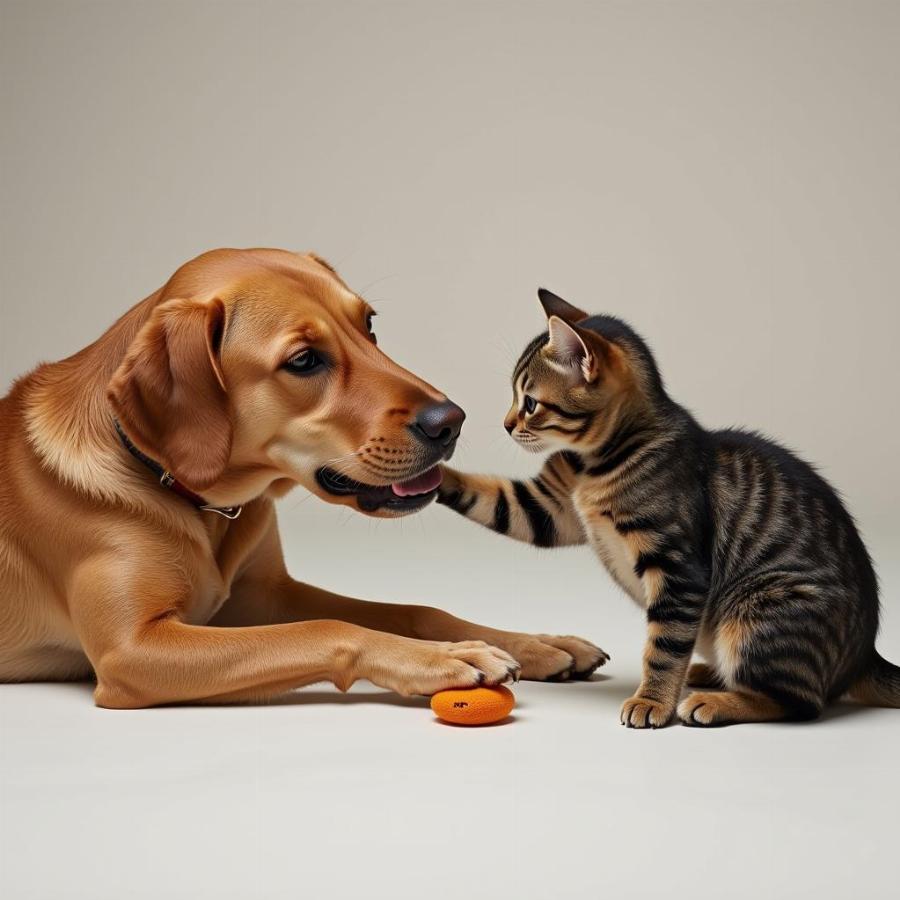Introducing a new dog to your resident cat can be a delicate process. It requires patience, planning, and a deep understanding of both animal’s behaviors. Done correctly, however, the introduction can lead to a harmonious, even loving, relationship between your furry friends. This guide will provide you with the essential steps to ensure a smooth and stress-free introduction, fostering a peaceful coexistence between your dog and cat.
Preparing for the Big Meet
Before the introduction even begins, laying the groundwork is crucial. This means preparing your home to accommodate both pets and minimize potential conflict. Start by setting up a safe space exclusively for your cat. This space should be inaccessible to the dog and include all the essentials: food, water, litter box, scratching post, and comfortable bedding. This provides a sanctuary for your cat to retreat to if they feel overwhelmed. Also, ensure your cat has plenty of vertical escape routes, like cat trees or shelves, to observe the dog from a safe distance. Familiarize your dog with your cat’s scent by offering them a blanket or toy that smells like the cat. Conversely, introduce your cat to your dog’s scent using the same method. This helps them acclimate to each other’s presence before a face-to-face meeting.
The Initial Introduction: Slow and Steady Wins the Race
The first introduction should be brief and supervised. Keep the dog on a leash and allow the cat to approach at their own pace. Never force an interaction. If the cat shows signs of stress, like hissing or flattened ears, separate them immediately and try again later. Reward calm behavior in both animals with treats and praise. Repeat these short, supervised introductions several times a day, gradually increasing the duration as they become more comfortable with each other.
Managing the First Few Weeks
Even after the initial introductions go well, continue supervising their interactions. Maintain separate feeding areas and litter boxes to avoid resource guarding. Provide plenty of toys and attention to both pets individually to prevent jealousy. Gradually allow them more unsupervised time together as they show signs of acceptance, like relaxed body language and mutual grooming.
Addressing Potential Challenges
What if your cat is particularly skittish or your dog overly enthusiastic? Adjust your approach accordingly. For timid cats, use a pheromone diffuser to create a calming environment. For excitable dogs, reinforce basic obedience commands like “sit” and “stay” to manage their behavior around the cat.
When to Seek Professional Help
If you encounter persistent aggression or fear, consult a certified professional dog trainer or a veterinary behaviorist. They can provide tailored guidance and address any underlying behavioral issues.
 Dog and Cat Playing Together
Dog and Cat Playing Together
Ensuring Long-Term Harmony
Introducing a dog to cats is a marathon, not a sprint. Even after they’ve adjusted to each other, continue providing separate spaces and resources. Regular playtime and individual attention will help maintain a positive relationship and prevent future conflicts. Be patient and understanding, and you’ll be rewarded with a peaceful and loving multi-pet household.
FAQs
- How long does it take for a cat and dog to get along? It varies greatly, from a few weeks to several months, depending on their individual personalities and the introduction process.
- What if my dog chases my cat? Redirect the dog’s attention with a toy or command. If the chasing persists, separate them and consult a professional trainer.
- Can I leave my dog and cat alone unsupervised? Only after they have consistently shown signs of acceptance and peaceful coexistence.
- Is it easier to introduce a puppy to a cat? Not necessarily. Puppies can be more energetic and less predictable than adult dogs.
- What if my cat hisses at my dog? Hissing is a normal cat behavior, indicating fear or discomfort. Separate them and try again later.
- Should I punish my dog for barking at my cat? Punishment is rarely effective and can worsen the situation. Focus on positive reinforcement and redirecting unwanted behavior.
- How do I know if my cat and dog are becoming friends? Signs of a positive relationship include relaxed body language, mutual grooming, playing together, and sleeping near each other.
Further Questions?
Explore these related articles on Beaut Dogs for more tips on pet care: gingerbread dog toy and remote control robot dog.
Conclusion
Introducing a dog to cats requires careful planning, patience, and a commitment to understanding your pets’ needs. By following these guidelines and adapting them to your specific situation, you can pave the way for a harmonious and loving relationship between your furry companions. Remember, a slow and steady approach, coupled with positive reinforcement, is key to successful integration.
Beaut Dogs is your go-to resource for all things related to show dogs, offering expert advice and a comprehensive understanding of the canine world. From breed specifics to grooming and training tips, we provide valuable insights to help you navigate the joys and challenges of dog ownership. For personalized support and detailed answers to your questions, contact us at [email protected]. We’re here to help you and your furry friend thrive. Visit us at https://beautdogs.com. You can also learn more about becoming foster parents for dogs with our guide, how to be foster parents for dogs and find information about emotional support harness for dogs. And if you’re looking for some fun, check out our cartoon dog with glasses.